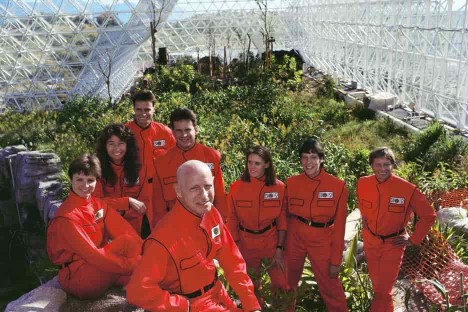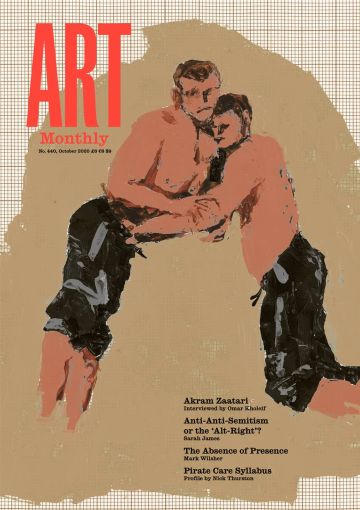Film
Matt Wolf: Spaceship Earth
Lin Er-Ying on the lessons to be learned from this cautionary tale of Biosphere 2, the spectacular but doomed 1980s ecological experiment

promotional photograph of the Biospherians at the launch of Biosphere 2
For the sterilised, quarantined mode of existence shared by so many around the world today, Matt Wolf’s new documentary Spaceship Earth provides fertile soil for sprawling feelings, unearthed reckonings and renewed insights. Wolf’s retelling of the story of Biosphere 2 – an immense ecological undertaking during the years 1991 to 1993 that once sent the world into frenzied scepticism – sets out to excavate the unmuddied hopes of its creators from the morass of media ridicule and corporate disputes.
Biosphere 2 was a 3.14-acre, airtight terrarium containing a closed ecological system located in Oracle, Arizona, designed as a prototype for colonies in space (Biosphere 1 is the earth). For the experiment, eight ‘biospherians’ lived in it for two years. The first 30 minutes of the film show the project’s spirited back story. We meet the Synergists, a commune/theatre troupe/corporation founded in San Francisco in the late 1960s by charismatic leader John Allen, and learn how they marched from one inspired venture to another, often with ‘planetary’ as the guiding word. These included the ‘Theatre of all Possibilities’, a sustainable ranch in New Mexico, an oceangoing ship in which they sailed the world, a hotel in Kathmandu, an art gallery in London, and the Institute of Ecotechnics, through which the Synergists organised scholarly conferences on ecology and climate change. The series of ventures eventually culminated in Biosphere 2. Grainy, luminous film footage of the exploration period is interposed with interviews in which Synergists’ members speak about their memories with a tender fondness that mirrors the pristine idealism that launched the enterprise three decades ago.
Funding was provided by billionaire oil heir Ed Bass, who had a passion for ecology and planned to profit in the long run by licensing the technology derived from the project. Research institutions around the country lent brain power. The immense structure rose from the ground and eight biospherians were selected. Biomes such as rainforest, savannah, desert and oceanic coral reef were installed using plant and animal species gathered from around the world. The crew used biblical metaphors, such as Noah’s Ark and the Garden of Eden, to describe this far-reaching inception, but Wolf shows how quickly the media strayed from their hopeful vision. In one clip, an incredulous TV host asks whether there will be any ‘cheating’ in the self-sustaining enclosure. Hungry for scandal, the media seized on the unusual origins of the project and pronounced it an unscientific ‘ecological entertainment’ from a ‘commune’ with ‘the trappings of a cult’. Despite Allen’s humble methodology of ‘learning by doing’ and prudent anticipation of probable failure, the media treated the experiment as a spectacle whose essence lay in the performance of the trick.
It is particularly poignant when biosepherian Linda Leigh enters the sealed space and turns the rain on in the forest to wash the air and, symbolically, to wash away the suspicions and negativity from the outside world. The rain delineates the tangible shape of this intimate relationship she is about to embark on with all living beings and with the atmosphere inside the terrarium. The film shows the crew working the field, taking notes and doing research (there were 64 separate research projects going on at the same time), or just hanging out together. They worked hard to take care of and recycle everything, maintaining the fragile balances inside the system that was sustaining their lives. We also see them dancing, laughing, playing and devouring banana cakes (there was no sugar in Biosphere 2). The compact world intensified and personalised the mutual stewardship between human and nature: even the simple act of picking out a sweet potato could create a surge in CO2 levels.
The project began to unravel when the media erupted over the ‘hidden’ carbon dioxide scrubber in Biosphere 2 and the fact that one of the biospherians brought back extra supplies after going to the hospital for an injury. The management’s failure to be transparent with the public only exacerbated the accusations. When a fast, mysterious decline of oxygen (later discovered to be caused by excessive amounts of organic matter in the soil) forced the management to pump oxygen into the enclosure to keep the crew alive, the attacks became ruthless: the oxygen input was called a violation of Biosphere 2’s premise which rendered the experiment ‘fake’ and ‘a total failure’. After the two years concluded, the pressure to end bad press led Bass to oust the original management and install the young Steve Bannon – yes, that Bannon – as the new CEO. Bannon had just left Goldman Sachs and his team quickly buried or destroyed all the scientific data and wrested the project out of its original vision and into a more profit-focused one. The same corporate backing that got Biosphere 2 off the ground led to its chilling conclusion, describing the arc of a cautionary tale.
In his interview, Allen laments that ‘people did not understand the point’. Spaceship Earth seeks to rediscover what the point is: the personal and ecological connection we have with every plant and every animal on this earth, which is a fundamentally closed system whose balances are delicately poised, and where each action carries its consequence. To even start to imagine the elusive solution to our environmental future, the first challenge is to have the same profound awareness of enclosure (even a sense of suffocation) and fatal connectivity – so vividly demonstrated in Biosphere 2 – in the seemingly open and infinite expanse of Biosphere 1.
Lin Er-Ying is a writer based in Chicago.
First published in Art Monthly 440: October 2020.











